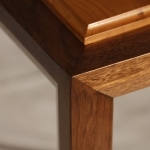I am building a conference table which has pedistal legs on each end. Each pedistal is made up of 1 inch stock edge glued to form a 6×24 rectangle with mitered corners in the plan view. I would like to wrap the bottom with molding. This creates a cross grain situation. Since the molding will be on all 4 sides, I cannot use the 3 sided techniques that allow for expansion in typical cabinet construction.
My solution is not to wrap the moulding across the grain of the pedistal, but to shorten the pedistals and have them sit on top of a separate base which is a more substantial version of the molding.
Are there other techniques for addressing this situation that you would recommend?
Thanks for your input.
Allen
















Replies
I had a similar situation in which I felt that using a T&G on the end grain would likely end up with some serious breakage. Obviously, this molding needs a lot of strength, so I hit on the idea of attaching it with epoxy glue with a backing behind the molding. Not very professional, but since the backing blocks can't be seen, the end result was very strong. By the way, my molding was curved, cut with a router and thus doubly likely to break.
Maybe that would work for you?
Dave,
Thanks for the reply.
How long was the cross grain piece that you glued? What was the wood? Is it comparable to 24" of cherry?
Allen
One possibility would be to have the molding not be glued to the pedestal. It'd have to be thick, but if you created a molding that had a dado on the inside, you could "hang" it from blocks glued to the pedestal, leaving expansion space for the pedestal to move. If you used foam or something like space balls the molding wouldn't tend to move around or rattle.
Just another thought.
John
Allen,
Just a thought here.
Instead of mitering the corners, (I'm not sure what this type of joint is called) you could make the long pieces full length, coping the ends to match the profile on the short pieces, and leaving room for their expansion / movement. And the short pieces would butt to the back of the long pieces. Does that make sense? Sorta like an old picture frame where the ends of the sides are profiled, not mitered.
jdg
jdg,
This makes sence, and I expect it would work very well. The end grain could be a problem with the dye (I am going to try to dye this piece instead of stain it). I will try some samples and see how this works.
Have you used dye on end grain?
If I was using stain, I could control this with sanding the end very very smooth and using paste stain. Does the same type of prep work with dye?
What do they call that type of joint? I would guess a coped joint, but I do not know either.
Thanks again,
Allen
Have you considered using veneer for this project. Since you are mitering the corners the substrate would not be seen and you would not have any wood movement issues to deal with. Is there a reason you are using solid stock on this table?
Tom,
Several times I have thought that this table would be a lot easier with plywood. However,...
My friend who commissioned the table specified the material and the basic style of the top edged in 10/4 material and the pedistal legs.
The edges of the top are 10/4, and the rest is made up of 4/4. The top has stopped mortise breadboard ends to deal with the cross grain. I have yet to flatten the top. Plywood would already be flat, but glued up boards unfortunately are not! 42 by 90 is a lot of awkward scraping.
Even though the corners of the pedistal legs are mitered, they are also rounded with a 3/4" radius cutter. I was going to stop the rounding 1 inch above the molding, but now am considering rounding the entire length of the corner and having the pedistal sit on a base platform.
The base platform will be 10/4, the same as the edge of the table, and with the same shape as the edge of the table, a combination of 3/4" radius on the top edge, and an indented relief which is made with the cutter that is typically used on the side of a handrail.
Thanks for your suggestion. Under different circumstances it would definitely be the choice.
Allen
This forum post is now archived. Commenting has been disabled